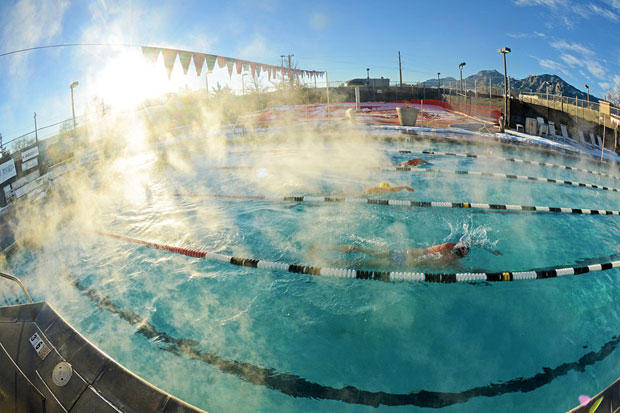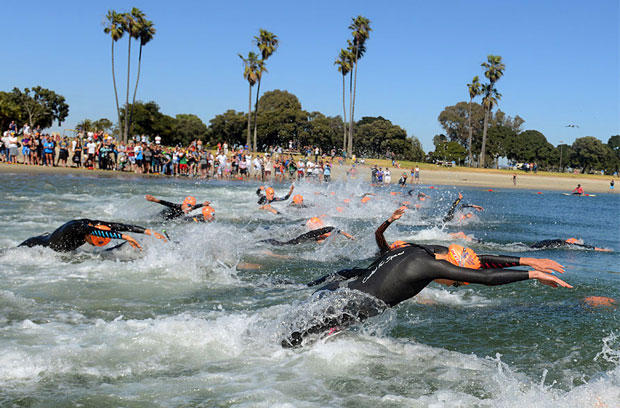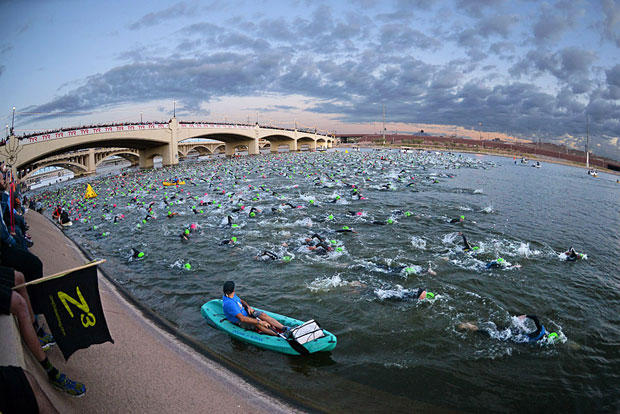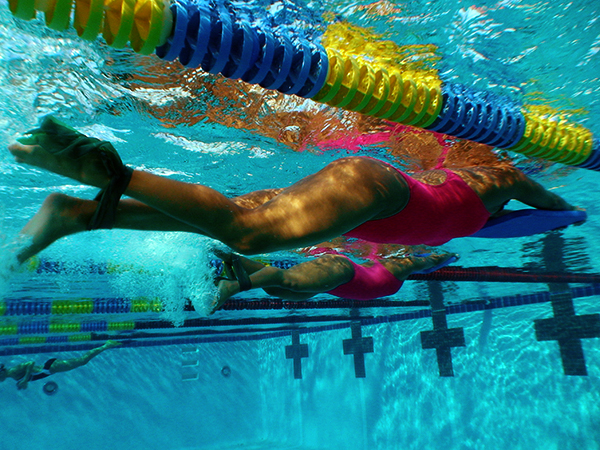Swim nomenclature
Like everyone who writes I am fond of my text and believe everybody will be edified who reads it. This noted, many or most of you will find what follows extraneous and are free to pass it by.
But if it's extraneous, why write it? We have a problem on Slowtwitch. We archive too much knowledge. That is, we have so much the sheer volume camouflages the very grain of expertise you need, or think you need. I have therefore embarked on the great work of synthesis, separating the wheat from the chaff, presenting the jewels of Slowtwitch in an easy-to-find format.
It will follow a motif called, "World of…" as in, the "World of Swimming", of Cycling, and so forth. This includes a change in the home page. It's a big navigational re-do and it will be foisted on you soon.
As a consequence of this you will see a few articles like this one. Consider them like ligaments, joining one repository of knowledge to another.

For example, if a reader wants to get better at swimming, it might be helpful to assess and identify where that reader sits along the gradient of poor to expert. Such an assessment requires knowing what certain swimming terms mean.
While what follows below is therefore necessary in the grand scheme, accomplished swimmers know what I'm writing below, so are excused.
LEAVE INTERVAL
If you were a runner growing up you might have run "intervals" and, if you did, the format is usually a given amount of rest after a given distance run.
So, maybe your run workout calls for 12x400m with 2min rest, my shorthand for running 400 meters (once around most tracks) a dozen times, and there's 2 minutes of rest between the end of the preceding 400m run and the beginning of the next one.
Swimming often doesn't do it that way. Usually the time increment includes both the activity increment and the rest. If it was done this way in running, and your quarters took 65 seconds each, then you might just decide to sacrifice 5sec of rest and leave every 3 minutes, the run + the rest altogether. Your "leave" would be "on the 3 minutes."
Translating this to swimming, we might then say that you are going to "leave" on the 2min for a set of hundreds, and if that's the case you'll swim 100 yards (or meters, as the case may be) in, say, a minute and a half. You'll get 30sec rest if your "leave interval" is 2 minutes.
Why does swimming do it that way? Because of the clock. The clock is always running on a pool deck. You can't start and stop it. You have to work within the confines of a running clock.
It is often the case that you'll choose a different leave interval depending on what you want to accomplish. If you want to work on top-end speed, you might swim 10x100yd "leaving" on the 2min. you'll swim each 100 fast, but you need more rest in between each. If you swim 10×100 leaving on the 1:40 you can't swim each 100 fast because you don't have as much rest.
If you just choose an average swim set, and what you'll typically choose as a leave interval, that interval for each 100 yards is emblematic of your ability. If you go to a Masters swim team workout, you might see the swimmers arranged in lanes, and in lane-1 it might be the 1:10 or 1:15 swimmers. These guys and gals might swim 10x100yd taking only just over a minute for each 100, then they "leave" on the 1:10 or 1:15. This is a really fast lane.
The next lane over, lane-2, might be the 1:20 lane, lane-3 might be the 1:30 lane and so forth. If you're swimming in the 1:20 lane you'll more often than not – but not always – perform a set of 100s on the 1:20 "base", or "repeating" on the 1:20. If the workout is a set of 200s, they might well be swum "repeating on the 2:40", which is still considered leaving on the "1:20 base".

How does this translate to times with which you might be familiar? Those who swim in the 1:10 lane, short course yards, will swim Ironman Hawaii in the front pack. They'll be out of the water in 50 minutes, or 51, or maybe 49 if it's a fast day. If a swimmer "leads" the 1:10 lane (leading a lane is tougher than swimming 2nd or 3rd in the lane, because the leader gets no draft) this might be a 47- or 48-minute Kona swimmer.
It seems to be fair to say that you add about 7 minutes to your Ironman swim time for every 10sec that you add to your leave interval (there was a Slowtwitch reader forum thread debating this). So, if 50min is fair guess for a Kona swimmer leaving in the 1:10 lane (SCY), then if you swim in the 1:20 lane you're roughly a 57min swimmer in Kona. If you leave in the 1:30 lane you're a 1:05 Kona swimmer. If the 1:40 lane you're a 1:12 swimmer. If the 1:50 lane a 1:20 swimmer, if you leave on the 2min you're a 1:25 to 1:30 swimmer. If you leave on the 2:20, repeating your 100s on the 2:20, maybe you're a 1:40 to 1:45 swimmer. If you leave on the 2:30 you're close to a 2-hour swimmer. If you leave on the 2:40 you're in danger of not making the swim cut-off in an Ironman.
This is helpful, I think, because if you swim 10x100yd and you "can't make the interval" leaving on the 2:40 base, you have work to do. However, if you do that work, and you can comfortably make the 2:20 base then you should have no trouble making the swim cut-off if you can translate your swim speed in the pool to the open water.
Why do I keep referring to the Kona swim? Because it's a non-wetsuit swim always, and it yields very consistent times. Adding a wetsuit, or a current, or fresh water, all changes the times, and a lot of swims are not consistent year over year.
TOP AND BOTTOM, SHORT AND LONG
When you're in a swim workout and your coach says, "leave on the top," what he's saying is that the next swim "leave", i.e., the next time you push off the wall and commence swimming, will occur at 12 o'clock, or, when the digital clock hits zero.
So many of today's pool clocks are digital, so it might not be intuitive, but the "top" refers back to the days when all our pool clocks were the large-faced analog clocks with minute and second hands. The top refers to the second hand hitting 12 o'clock, i.e., the top of the clock. The bottom is the :30.
Everything else is just the time increment around the face of the clock. "Leave on the 40" means the next time the clock hits the 40-second point (regardless of what minute the clock is on). So, leave on the 15, the 20, the 45, should now make sense to you if it didn't already.
May I digress for a moment? I like to do sets that leave on some multiple of :15 or :20, and I do the former in multiples of 4 and the latter in multiples of 3. Anything that finishes on the :30 I like to do in multiples of 2. So, 12×100 leaving on the 1:20 or 1:40 means that I'm back leaving "on the top" after completing 3 of them. This helps me keep track. If I do 12×100 on the 1:40, it takes 5 minutes to complete around of 3×100, so, that set of a dozen 100s takes me exactly 20 minutes to complete. I note the minute on which I'm leaving. If I leave when the clock says 10 minutes then I'll finish the set when the clock says 30 minutes. Let's say I wanted to swim 200s repeating on the 3:15. I would probably do 4 of these, or 8, because after every 4 I'm back on the top. If I did 4 of these, the whole set will take 13 minutes; 8 of them in 26min.
I threw a couple of acronyms and terms at you, just above, let's decode them. When we say "short course" we mean a pool that is set up in a 25-something configuration. That something might be yards of meters. If it's 25 yards we call that short course yards (SCY). If it's 25 meters it's short course meters. If you jump in an unfamiliar pool and you are swimming horribly slowly and you don't know why, ask the lifeguard, maybe you're in a short course meters pool, and you assumed it was yards. On average, you'll swim about maybe 10sec slower per 100 if you're swimming in a SCM pool.
Long course is 50 meters. Always meters. Most 50 meter pools are built so that it's 50 meters one way and 25 yards the other. There are swimming seasons, and short course season (short course national championships, etc.) are swum in 25-yard pools, long course is 50 meters. The Olympics are always long course, always meters, always 50 meters. Long course is slower than short course. While SCM is 10sec or so slower than SCY, LCM is 12sec, on average, slower than SCY. Why? Because turns are faster than swimming. All the SCM records are faster than LCM records because every event has more turns. If you swim LCM faster than SCM you are a truly horrible turner.

And this does bring up a point, which is that there's some noise in the equations when translating pool speed to open water speed. In triathlons, especially in ocean swims, I used to routinely "outswim" my pool speed because I grew up on the beach, was a good open water swimmer, was good at tides, waves, currents, I drafted well in the open water, and because I was not a fast turner in the pool compared to others in my competitive set. You took the turns out and I got "faster" (compared to those who swam about my speed, but who came from a swimming background). If you are a non-swimmer this should give you hope, because you can make up for pool deficiencies. This is why lifelong surfers make great open water swimmers. They understand open water better than pool swimmers do, at least if the race is in the ocean.
STROKE
Non-swimmers will sometimes hear a masters coach say something like, "These 100s are going to be 50 free, 50 stroke." What stroke? Stroke in this case means anything but freestyle. So, if you are a backstroker on IM day you might want to swim backstroke whenever the set includes "stroke". When it's IM day that means there's going to be a lot of stroke in the workout, IM standing for "individual medley." This is a race where you perform all the strokes: butterfly, backstroke, breaststroke and freestyle. It's typical for masters teams to have at least 1 day a week IM day. It's also typical for triathletes to be AWOL on that day.
Some notes on etiquette. If you're new to a masters swim team, neither overestimate your ability nor sandbag. If there are several in a lane, choose a lane you can comfortably swim in (i.e., if you can make the 1:40 base pretty easily, but the 1:30 base is a stretch, jump in the 1:40). Swim near the end of the lane (don't immediately lead the lane). It will become clear quickly if you need to move up, and you won't have to make the suggestion, the person in front of you will suggest it. Leave 5sec after the person in front of you. If that person leaves early, say, after 3sec, then you leave 7sec after him, to get the lane back on schedule. You can "motor up the stagger" if you need to in order to make the interval, that is, you can swim like a sonofabitch during the first 25 or 50 yards to catch the draft of the person in front of you, but not by leaving early, and don't get too close! Don't touch his feet. By the time you're halfway through your first workout with this group, they will have sorted out your proper lane, and place in the lane, for you.
Then there's the pool itself. The black line along the bottom is a "lane marker". At both ends of each lane marker is a "T". The plus sign on the wall at the end of each lane is called a "target". The cables with buoys dividing each lane, on the surface, are called variously lane lines, lane dividers or racing lanes. In the air above you are cables with flags attached perpendicular to the lanes, near the ends of the lanes, which are called "backstroke flags" (these flags let the backstrokers know when they're so many feet from the wall: 5 meters from the wall in LC pools, 15 feet from the wall in SCY pools).
Swimming circles refers to how you negotiate the lane with more than 2 swimmers in it. If there are only 2 in the lane you might "split" the lane, each of you taking a side. Swimming circles means you hug the side of the lane, always keeping the lane line on your right (you'll swim counter-clockwise). A "length" is one swim across the pool. A "lap" is 2 lengths (a round trip). Dolphin kick is what occurs during butterfly. Flutter kick is what you do in freestyle.
Slightly more advanced are kicking (such as 2-, 4-, and 6-beat kicking) and breathing patterns (such as the infamous 2:3 pattern we espouse here on Slowtwitch), and I'll devote entire articles to these.


